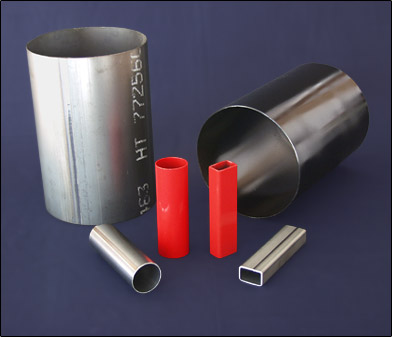These sections are cut from 4 inch structural tubing produced from SCS coils.
The very smooth, clean surface makes them both 'ready-to-weld' and 'ready-
to-paint' as they come off the tube mill. |
qualities become especially valuable
to them. The tube ran wonderfully, but
wasn't quite as clean coming off the
mill as the round tube. Reason: the |
|
oil-based coolant used was quite |
dirty and fouled the surface of the tube. As expected, there was some scale powdering on the inside of the bends, but the producer felt this would not be of any concern to the customer.
Two weeks later, coils of 16 gauge SCS were delivered to a major pipe producer for their trials which resulted in the two large pipe sections shown in the photo above (one painted and one bare). This producer uses hot-rolled and applies a transparent protective coating to selected products. That coating doesn't apply as uniformly to hot rolled as the producer would like; he's counting on SCS' smoothness and cleanliness to give him the consistently uniform coverage and high quality finish you expect of a premium product.
|
The SCS coils certainly performed like a premium steel on the pipe mill. "This is, without a doubt, the nicest coil of 14 gauge I've ever run on this mill," the operator commented while running his first SCS coil, "and I've been runnin' this mill for 20 years!" He felt the smooth, even edge of the SCS coil made for better welding. He also felt the very smooth SCS surface, with just a thin layer of scale, would extend the life of the welding unit's copper contacts. "We've run pickled dry and it's so rough that you can almost watch the contacts being ground down. The scale on hot-rolled has some kind of a 'lubricating' effect and helps the contacts last longer. But normal hot-rolled surface is a lot rougher than the SCS and the heavier, loose scale on hot-rolled can be rough too, so I expect our contacts may last even longer with the SCS."
Additional tubing trials have been conducted by other US and Canadian producers who have been extremely impressed with SCS performance. That's not to say there aren't adaptations tube and pipe producers will need to make to get the most from SCS. For example, dirty oil-based coolants will leave deposits on the SCS tube and defeat the purpose of using such a clean material. Switching to a filtered water-based coolant would be the appropriate solution. Also, seam welding is usually the speed limitation of a tube or pipe mill, and the SCS coil's excellent shape and cleanliness appears to be a key to raising this limit. Still, careful monitoring of weld quality needs to accompany any increases in line speed to make sure there's no adverse tradeoff.
|
In summary, after trials from some of America's premier tube and pipe producers (who will remain anonymous in order to protect their competitive advantage) we feel confident stating that SCS offers an excellent opportunity for tube and pipe producers to simplify material sourcing, improve quality, and even increase throughput. Most importantly, it can let them provide their customers with a more consistent product that's practically 'ready-to-weld/ready-to-paint' right off the mill.
|
|
 |

